Offices of the Brenner Base Tunnel project in Franzensfeste, South Tyrol. When completed, this will be the longest train tunnel in the world, stretching 64 kilometers (40 miles) between Innsbruck and Franzensfeste. It is more than 580 meters (1900 feet) below the surface as it passes underneath the border of Austria and Italy at the Brenner Pass in the Tyrolean Alps. Photo taken in November, 2019. Click here for more info.
Month: November 2019
Stuck, Ch. 3. Born Again: Fleetwood Mac, “Monday Morning”
by Akim Reinhardt
Stuck is a new weekly serial appearing at 3QD every Monday through early April. A Prologue can be found here. A table of contents with links to previous chapters can be found here.
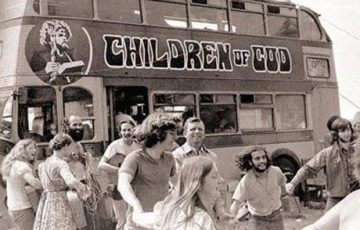 I never met Jeremy Spencer, so I can only guess. I suspect he was searching for something. Only 23 years old, perhaps he was unhappy with himself, or the world around him. Perhaps he was scared and craving shelter from the storm. Perhaps he dreamed of what could be, or pined for a grand voyage. Maybe he just got lost.
I never met Jeremy Spencer, so I can only guess. I suspect he was searching for something. Only 23 years old, perhaps he was unhappy with himself, or the world around him. Perhaps he was scared and craving shelter from the storm. Perhaps he dreamed of what could be, or pined for a grand voyage. Maybe he just got lost.
Either way, in 1971 Spencer went out for a magazine and never came back. When friends tracked him down several days later, they found he’d joined a small, new, secretive religious group called Children of God. Today it’s known as The Family International, and infamous for being the cult that the Phoenix children (including River and Joaquin) grew up in. According to Wikipedia, anyway, Spencer is still a member.
Prior to joining Children of God, Spencer had been a member of something else: Fleetwood Mac. And his departure from the band marked the second time in less than a year that one of their original guitarists had left to find God. Read more »
Michael Chabon: “I love Mr. Spock because he reminds me of you, I told my father”
Michael Chabon in The New Yorker:
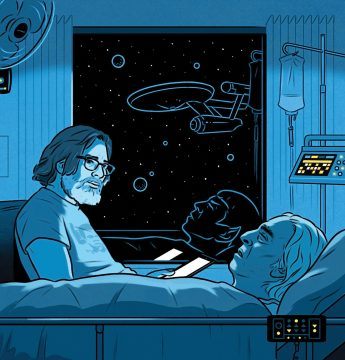 Ensign Spock, a young half-Vulcan science officer fresh out of Starfleet Academy and newly posted to the Enterprise, found himself alone in a turbolift with the ship’s formidable first officer, a human woman known as Number One. They were waiting for me to rescue them from the silence that reigns in all elevators, as universal as the vacuum of space.
Ensign Spock, a young half-Vulcan science officer fresh out of Starfleet Academy and newly posted to the Enterprise, found himself alone in a turbolift with the ship’s formidable first officer, a human woman known as Number One. They were waiting for me to rescue them from the silence that reigns in all elevators, as universal as the vacuum of space.
I looked up from the screen of my iPad to my father, lying unconscious, amid tubes and wires, in his starship of a bed, in the irresolute darkness of an I.C.U. at 3 a.m. Ordinarily when my father lay on his back his abdomen rose up like the telescope dome of an observatory, but now there seemed to be nothing between the bed rails at all, just a blanket pulled as taut as a drum skin and then, on the pillow, my father’s big, silver-maned head. Scarecrow, after the flying monkeys had finished with him. His head was tilted upward and his jaw hung slack. All the darkness in the room seemed to pool in his open mouth.
Hey, Dad, I need a line, I said, breaking, if only in my head, the silence that reigned between us. I’m writing dialogue for Mr. Spock.
I’d tried talking aloud to my father a few times in the hours since he’d lost consciousness, telling him all the things that, I’d read, you were supposed to tell a dying parent.
More here.
Oncologist Azra Raza: ‘Don’t give up hope. Don’t give in to despair’
Andrew Anthony in The Guardian:
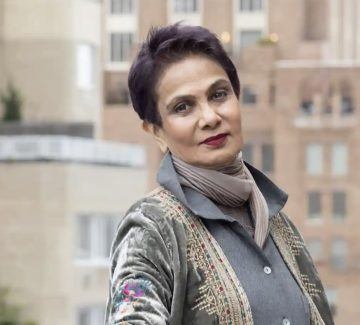 Azra Raza is an oncologist, and professor of medicine and director of the Myelodysplastic Syndrome Center at Columbia University, New York. She was married to Harvey Preisler, another eminent oncologist, who died of lymphoma in 2002. Her new book, The First Cell, argues against the current preoccupations of cancer research and treatment. Instead of trying to destroy the last cancer cell, says Raza, we should invest more money in preventive treatments that enable us to detect the first cancer cell.
Azra Raza is an oncologist, and professor of medicine and director of the Myelodysplastic Syndrome Center at Columbia University, New York. She was married to Harvey Preisler, another eminent oncologist, who died of lymphoma in 2002. Her new book, The First Cell, argues against the current preoccupations of cancer research and treatment. Instead of trying to destroy the last cancer cell, says Raza, we should invest more money in preventive treatments that enable us to detect the first cancer cell.
What made you decide to become an oncologist?
I have been interested instinctively in natural things since as long as I can remember. As I grew older, I really wanted to study Darwinian evolutionary biology. Then I wanted to study molecular biology. But there was no way for me to study science in Pakistan, where I grew up, so the only entry into science was through medicine, and I went to medical school. Once I had a clinical experience with patients, I knew this was something I would have to dedicate my life to.
More here.
Austerity Is Not the Only Way: Portugal!
David Byrne and Will Doig in Reasons to be Cheerful:
 After the 2008 financial mess, austerity was touted as an economic cure-all. Deep budget cuts were forced upon nations and their citizens as a prerequisite for bailout loans. Now, we’re seeing the fallout. Anti-austerity protests have gripped countries around the world, from Chile to Ecuador to Lebanon to Zimbabwe. We should have seen this coming—austerity isn’t the only option, or even the best one, for countries in fiscal distress. In fact, one country has proven that rejecting austerity is not only a way to survive, but to flourish. That country is Portugal.
After the 2008 financial mess, austerity was touted as an economic cure-all. Deep budget cuts were forced upon nations and their citizens as a prerequisite for bailout loans. Now, we’re seeing the fallout. Anti-austerity protests have gripped countries around the world, from Chile to Ecuador to Lebanon to Zimbabwe. We should have seen this coming—austerity isn’t the only option, or even the best one, for countries in fiscal distress. In fact, one country has proven that rejecting austerity is not only a way to survive, but to flourish. That country is Portugal.
Compare Portugal today with Britain. One could argue that the Cameron administration’s austerity policies created the anger and frustration than eventually led to Brexit. Austerity in Italy and Greece, too, seems to have fostered a surge in far-right politics. What’s worse, austerity hasn’t even done what it was supposed to: save faltering economies. A paper issued by the IMF’s chief economist five years after the financial crisis concluded that every dollar cut from government budgets actually reduced economic output by $1.50.
More here.
Scientists Confirm Music Is Universal, And It Is Used In ‘Strikingly Similar Ways’ Across The Globe
Kashmira Gander and Rosie McCall in Newsweek:
 Scientists have confirmed every society on the planet makes music and it is used in “strikingly similar ways,” from lullabies to love songs.
Scientists have confirmed every society on the planet makes music and it is used in “strikingly similar ways,” from lullabies to love songs.
To arrive at this conclusion, researchers spent five years painstakingly creating a database that features music created by people across the globe. They dubbed it the Natural History of Song.
With the help of experts who provided access to music archives the world over, the team were able to study field recordings of performances from each of the planet’s 30 regions. These ranged from love songs and lullabies to music intended to heal from everywhere from Australia, to the Pacific Northwest, and Northern Africa. Cassettes, vinyl, reel-to-reels, CDs and digital recordings were dug up for the cause.
Samuel Mehr, a fellow of the Harvard Data Science Initiative and research associate in psychology, recalled in a statement how he asked a librarian at the institution to help, and 20 minutes later was presented with a cart of 20 cases of reel-to-reel recordings of traditional Celtic music.
To answer whether there is any truth to the commonly held belief that music is universal, the team also collected almost 5,000 descriptions of music by ethnographers who immersed themselves in 60 societies.
More here.
The blurred history of Orientalist art
Nicolas Pelham in MIL:
 Like many students of the Middle East, I am still haunted by Edward Said 41 years after he wrote “Orientalism”. The seminal book argued that Western academics, writers, artists and journalists had been agents of European soft power for over two centuries, constructing an image of the East that was exotic and therefore in need of taming. Orientalists’ art, literature, maps and artefacts reinforced the superior mindset of colonialists and whetted the appetite of Western governments to invade and possess Eastern nations, according to Said. His ideas shook up coverage of the Middle East years before I began working as a journalist in the region, but I wrote racked with guilt. On one of my first assignments in Egypt, the British embassy in Cairo flew me with the then British prime minister, John Major, to visit the war cemeteries that Britain tends for soldiers killed fighting in the deserts of El Alamein during the second world war. It was a privilege rarely afforded to a young reporter and they expected a puff piece. I returned with a report about irate locals demanding Britain give up control of a site commemorating battles between two invading European armies on Egyptian soil. I titled it “Egypt for the Egyptians”.
Like many students of the Middle East, I am still haunted by Edward Said 41 years after he wrote “Orientalism”. The seminal book argued that Western academics, writers, artists and journalists had been agents of European soft power for over two centuries, constructing an image of the East that was exotic and therefore in need of taming. Orientalists’ art, literature, maps and artefacts reinforced the superior mindset of colonialists and whetted the appetite of Western governments to invade and possess Eastern nations, according to Said. His ideas shook up coverage of the Middle East years before I began working as a journalist in the region, but I wrote racked with guilt. On one of my first assignments in Egypt, the British embassy in Cairo flew me with the then British prime minister, John Major, to visit the war cemeteries that Britain tends for soldiers killed fighting in the deserts of El Alamein during the second world war. It was a privilege rarely afforded to a young reporter and they expected a puff piece. I returned with a report about irate locals demanding Britain give up control of a site commemorating battles between two invading European armies on Egyptian soil. I titled it “Egypt for the Egyptians”.
Since the publication of “Orientalism” in 1978 many museums and art galleries have hidden away their collections of desert landscapes, desolate ancient ruins and other memorabilia from 19th-century tours of the Orient. A new exhibition at the British Museum attempts to cast off the guilt and shame. Its neutral title – “Inspired by the East: how the Islamic world influenced Western art” – seems to strip art of political baggage. “We’re hoping to move beyond Said,” explains a curator. The exhibition hopes to highlight the quality of Orientalist art, presenting it as a more sincere – and surprising – cultural exchange.
The curators are right that Orientalism is more complex and blurred than Said believed.
More here.
Abandoned malls are sputtering back to life with megachurches, rooftop pools and homeless shelters
Abha Bhattarai in The Washington Post:
 Dozens nationwide have shuttered in the past decade, and a quarter of the estimated 1,100 that remain are projected to follow by 2022, opening large swaths of empty space. “We built too many malls, and we built them too cheaply,” said Amanda Nicholson, a professor of retail practice at Syracuse University. “Only the strong will survive, while the weaker ones idle and fold.” The die-off has created challenges for the municipalities and developers tasked with repurposing millions of square feet of vacant retail space and parking lots. But the successes have taken multiple forms: community colleges, public preschools, churches and libraries. Some old malls have turned into micro-apartments or microbreweries, and at least one abandoned shopping mall is now an Amazon fulfillment center, offering a glimpse into consumers’ shifting habits and priorities.
Dozens nationwide have shuttered in the past decade, and a quarter of the estimated 1,100 that remain are projected to follow by 2022, opening large swaths of empty space. “We built too many malls, and we built them too cheaply,” said Amanda Nicholson, a professor of retail practice at Syracuse University. “Only the strong will survive, while the weaker ones idle and fold.” The die-off has created challenges for the municipalities and developers tasked with repurposing millions of square feet of vacant retail space and parking lots. But the successes have taken multiple forms: community colleges, public preschools, churches and libraries. Some old malls have turned into micro-apartments or microbreweries, and at least one abandoned shopping mall is now an Amazon fulfillment center, offering a glimpse into consumers’ shifting habits and priorities.
Here, a look at five ways malls around the country are coming back.
Homeless shelter
At first the idea elicited incredulity: a homeless shelter in a shopping mall? Carpenter’s Shelter was 18 months into its search for a new space in Alexandria when someone mentioned a local shopping mall that had fallen into disarray. “Everyone chuckled as though it was going to be a running joke,” said Shannon Steene, the nonprofit’s executive director. “But now here we are: a 60-bed shelter at the old Landmark Mall.” The mall’s owner, the Howard Hughes Corp., is not charging any rent. Eventually, though, it plans to demolish the mall and replace it with a mixed-use development. The shelter will move out of the mall next summer, when it finishes renovating a former Department of Motor Vehicles building. The shelter takes about 18,000 square feet in a former Macy’s. A Sears store in another part of the mall is still open to the public. Other parts of the mall were recently used to film scenes for the upcoming “Wonder Woman” sequel.
More here.
Jack O’Dell (1923 – 2019)
Mustapha Matura (1939 – 2019)
Kehinde Lijadu (1948 – 2019)
Sunday Poem
At Least
Just wait, to see what’s going to happen.
.
by Raymond Carver
Branko Milanovic: Why we are all Capitalists now! And how this could reduce inequality
My Life as a Child Chef
 Adam Shatz in The New Yorker:
Adam Shatz in The New Yorker:
Twice a month, when my daughter, Ella, spends the weekend with me, my apartment turns into a cooking school. Ella is thirteen and started to make cookies and scones a few years ago. She moved on to tarts, fresh tagliatelle, and, lately, croissants. Early on Saturdays, before heading to our local green market, we have impassioned conversations about her dinner plans. Pork adobo with citrus and coriander, she asks me, or red lentils simmered Ethiopian-style, with fresh tomatoes and berbere? And then she’s sure to ask if she can bake. I’m already thinking of the scabs of flour I’ll be scraping off my counter on Monday morning, and of how much pâtisserie I’ll have consumed, but I give in. I love watching the skill and authority of her fingers in a bowl of flour, eggs, butter, and chocolate; her intensity as she pipes ganache from a pastry bag or dusts éclairs with finely ground pistachios.
When she’s not cooking, she often watches shows like “Chef’s Table,” the sumptuously produced Netflix series featuring sombre, admiring portraits of culinary stars. With painterly cinematography and introspective voice-overs, “Chef’s Table” pays professional cooks the kind of homage once reserved for artists. Most of the dishes are impossible to replicate in a home kitchen—who has the time to make Enrique Olvera’s thousand-day mole, or even find all the ingredients?—but Ella doesn’t watch the show for recipes. She watches it for the spectacle of mastery, much as other teens hang out on YouTube watching Lionel Messi’s greatest goals or Yuja Wang playing “Flight of the Bumblebee.”
The show’s self-serious musings on the mysteries of food make me cringe a bit, but I was once fluent in that idiom. From the time I was nine until well into my teens, I was determined to be a chef. I ran a catering business out of my parents’ house, in Longmeadow, Massachusetts, and did apprenticeships with notable chefs.
More here.
The Fall of Nate Silver
 Aaron Timms in The New Republic:
Aaron Timms in The New Republic:
Did he change, or did we? For weeks now, Nate Silver has been morphing before our eyes into exactly the kind of bloviator he made his name mocking. Tired perhaps of the slow and predictable business of prognostication—the elections so far apart from each other, the long months of waiting and lousy web traffic in between—the founder of data journalism outlet FiveThirtyEight has transformed his Twitter account into a font of provocatively bad opinions. Some of Nate’s Takes have touched on his speciality in data-based political forecasting: He has told us, for instance, not to get too excited about Democratic candidates’ (read: Bernie’s) fundraising numbers because polls, rather than cash, are the best predictor of electoral success, whereas a year ago he was saying just the opposite. But he has also wandered into more exotic territory, offering up a mix of bad policy ideas (elite colleges should admit as many legacy students and children of rich donors as they want) and sanctimonious tone policing (liberals should feel ashamed of themselves for not allowing the president to revel in the murder of ISIS’s chief lieutenant) with the unyielding, over-the-spectacles glare of an imaginary Concerned of Brooklyn Heights.
John von Neumann, A Documentary
Dominion by Tom Holland – The Legacy of Christianity
Terry Eagleton at The Guardian:
 Other intriguing details abound. When Notre Dame was being built in medieval Paris, a collective of prostitutes offered to pay for one of its windows and dedicate it to the Virgin Mary. Followers of Satan around the same time were obliged to suck on the tongue of a giant toad and lick the anus of a black cat. Galileo had a craving for celebrity and was an inveterate social climber. Yet, though the book is full of such titbits, there is a seriousness at its heart. Holland argues that all “western” moral and social norms are the product of the Christian revolution. He is haunted by St Paul’s claim that God chose the weak and foolish things of the world to shame the strong, and to drive the point home he might have looked at the beginning of Luke’s gospel. We encounter there an obscure young Jewish woman called Mary who is pregnant with Jesus, and Luke puts into her mouth a cry of praise that some scholars believe is a Zealot chant. It speaks of how you will know who God is when you see the poor coming to power and the rich sent empty away. It is this which must be weighed in the balance against the killing fields of Christendom.
Other intriguing details abound. When Notre Dame was being built in medieval Paris, a collective of prostitutes offered to pay for one of its windows and dedicate it to the Virgin Mary. Followers of Satan around the same time were obliged to suck on the tongue of a giant toad and lick the anus of a black cat. Galileo had a craving for celebrity and was an inveterate social climber. Yet, though the book is full of such titbits, there is a seriousness at its heart. Holland argues that all “western” moral and social norms are the product of the Christian revolution. He is haunted by St Paul’s claim that God chose the weak and foolish things of the world to shame the strong, and to drive the point home he might have looked at the beginning of Luke’s gospel. We encounter there an obscure young Jewish woman called Mary who is pregnant with Jesus, and Luke puts into her mouth a cry of praise that some scholars believe is a Zealot chant. It speaks of how you will know who God is when you see the poor coming to power and the rich sent empty away. It is this which must be weighed in the balance against the killing fields of Christendom.
more here.
Music and Fascism Fifty Years After Adorno
Andrew Marzoni at The Baffler:
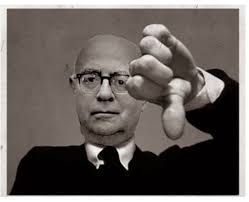 Adorno was known for his skill at anticipating apparent contradictions, gymnastically reframing objections to his theses as their necessary conclusions, and he would not have been shocked by the cultural capital afforded his byline any more than the ongoing devaluation of the art he held above all else. An insufferable elitist who championed art for refusing to conform to the standards of public consumption, his bad takes on jazz—attributing its popularity to sadomasochism, comparing the jitterbug to St. Vitus’s dance—are lamented, and sometimes excused for their ignorance: the only jazz Adorno knew, which he pronounced more like “yatz,” was the kind played by the Paul Whiteman Orchestra and increasingly derivative (mostly Caucasian) dance bands that entertained the Weimar bourgeoisie. As Stuart Jeffries notes in Verso’s Grand Hotel Abyss, Adorno spent the 1940s only a few miles from the clubs on Central Avenue where Dexter Gordon, Eric Dolphy, and Charles Mingus inaugurated a bop renaissance on the West Coast, but there’s no record of the critic going anywhere near them. According to New Yorker critic Alex Ross, Adorno “shows no sympathy for the African-American experience, which was finding a new platform through jazz and popular song. The writing is polemical, and not remotely dialectical.”
Adorno was known for his skill at anticipating apparent contradictions, gymnastically reframing objections to his theses as their necessary conclusions, and he would not have been shocked by the cultural capital afforded his byline any more than the ongoing devaluation of the art he held above all else. An insufferable elitist who championed art for refusing to conform to the standards of public consumption, his bad takes on jazz—attributing its popularity to sadomasochism, comparing the jitterbug to St. Vitus’s dance—are lamented, and sometimes excused for their ignorance: the only jazz Adorno knew, which he pronounced more like “yatz,” was the kind played by the Paul Whiteman Orchestra and increasingly derivative (mostly Caucasian) dance bands that entertained the Weimar bourgeoisie. As Stuart Jeffries notes in Verso’s Grand Hotel Abyss, Adorno spent the 1940s only a few miles from the clubs on Central Avenue where Dexter Gordon, Eric Dolphy, and Charles Mingus inaugurated a bop renaissance on the West Coast, but there’s no record of the critic going anywhere near them. According to New Yorker critic Alex Ross, Adorno “shows no sympathy for the African-American experience, which was finding a new platform through jazz and popular song. The writing is polemical, and not remotely dialectical.”
more here.
Agnès Varda’s Extraordinary Cinematic Accomplishment
Richard Brody at The New Yorker:
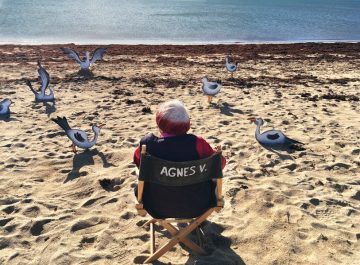 Agnès Varda’s film “Varda by Agnès,” which is being released posthumously, on Friday (she died in March, at the age of ninety), is her retrospective of her own career, punctuated by deep dives into her personal life and newly filmed sidebars of interviews and self-displaying theatrics. Yet it’s more than just Varda’s last movie; it’s the last scene of her last act, the capper to a twenty-year span of work that includes some of her most original and significant films. At the same time, this period in her career and her life coincides with a shift in the history of cinema that she helped to define and that she responded to with a practical inspiration that is a mark of her historic art. That very story is one that she tells in “Varda by Agnès.”
Agnès Varda’s film “Varda by Agnès,” which is being released posthumously, on Friday (she died in March, at the age of ninety), is her retrospective of her own career, punctuated by deep dives into her personal life and newly filmed sidebars of interviews and self-displaying theatrics. Yet it’s more than just Varda’s last movie; it’s the last scene of her last act, the capper to a twenty-year span of work that includes some of her most original and significant films. At the same time, this period in her career and her life coincides with a shift in the history of cinema that she helped to define and that she responded to with a practical inspiration that is a mark of her historic art. That very story is one that she tells in “Varda by Agnès.”
Varda relies on a pair of public discussions to structure the overview of her career. The first hour leaps around, juxtaposing her films from different decades and circumstances by way of her insightful thematic connections, and ends at a crucial waypoint in her life: her last dramatic feature, which she made in the mid-nineteen-nineties.
more here.
The Quiet Rebellions of Hala
Hannah Giorgis in The Atlantic:
 Hala, the new film from the writer-director Minhal Baig, is a study in contrasts. The coming-of-age story follows its titular protagonist, a Pakistani American teenager played by Geraldine Viswanathan, as she navigates the confusion of adolescence in the United States. The divides she encounters are apparent almost immediately: parents versus classmates; Pakistan versus America; Islamic tenets versus romantic freedom. Hala skateboards to school and writes poetry. She also clashes with her strict mother and father, who chide her relentlessly for any number of activities her white friends speak about with casual disregard.
Hala, the new film from the writer-director Minhal Baig, is a study in contrasts. The coming-of-age story follows its titular protagonist, a Pakistani American teenager played by Geraldine Viswanathan, as she navigates the confusion of adolescence in the United States. The divides she encounters are apparent almost immediately: parents versus classmates; Pakistan versus America; Islamic tenets versus romantic freedom. Hala skateboards to school and writes poetry. She also clashes with her strict mother and father, who chide her relentlessly for any number of activities her white friends speak about with casual disregard.
Movies about teens fighting with their parents are nothing new. But in examining the binaries that 17-year-old Hala confronts, Baig’s film joins a growing group of films and TV shows centered on young Muslim characters in America. Like some prior productions, including Aziz Ansari’s Netflix series Master of None and Kumail Nanjiani’s romantic comedy The Big Sick, Hala has received criticism for featuring yet another protagonist who has a fraught relationship with Islam and who sees her white love interest as one key to self-actualization. Capturing an entire community’s relationship to their religion is a staggering mandate, one that’s impossible for any one production (or two or three) to achieve. As a result, Hala is sharpest when viewed on its own terms—that is, in the way many coming-of-age films about white teens are. The film stands out most for its deft character work with Hala and her parents, especially when it doesn’t treat the trio as case studies for sweeping ideas about Muslim identity.
More here.

